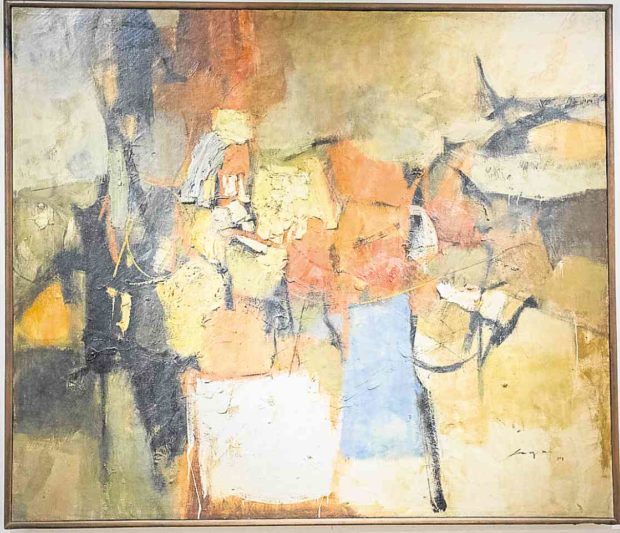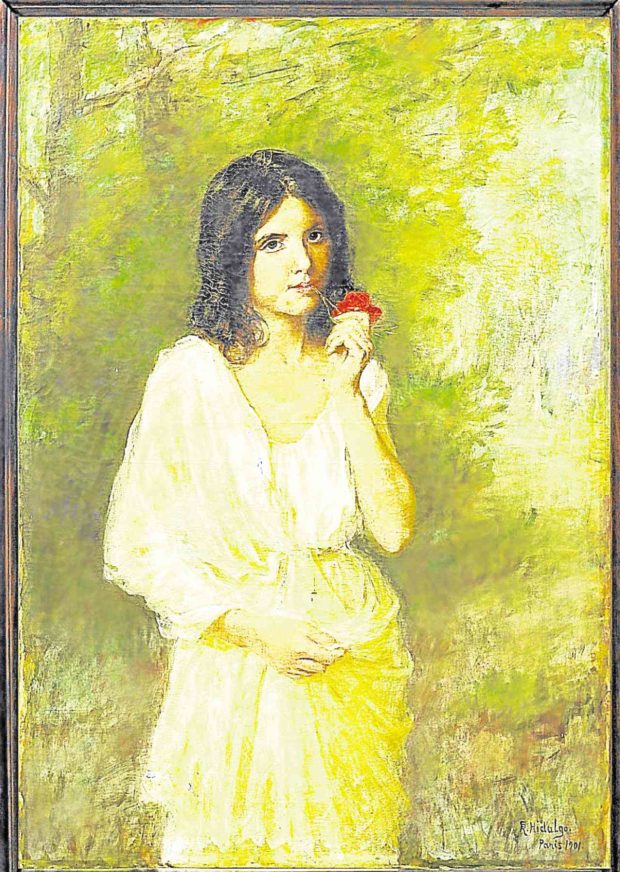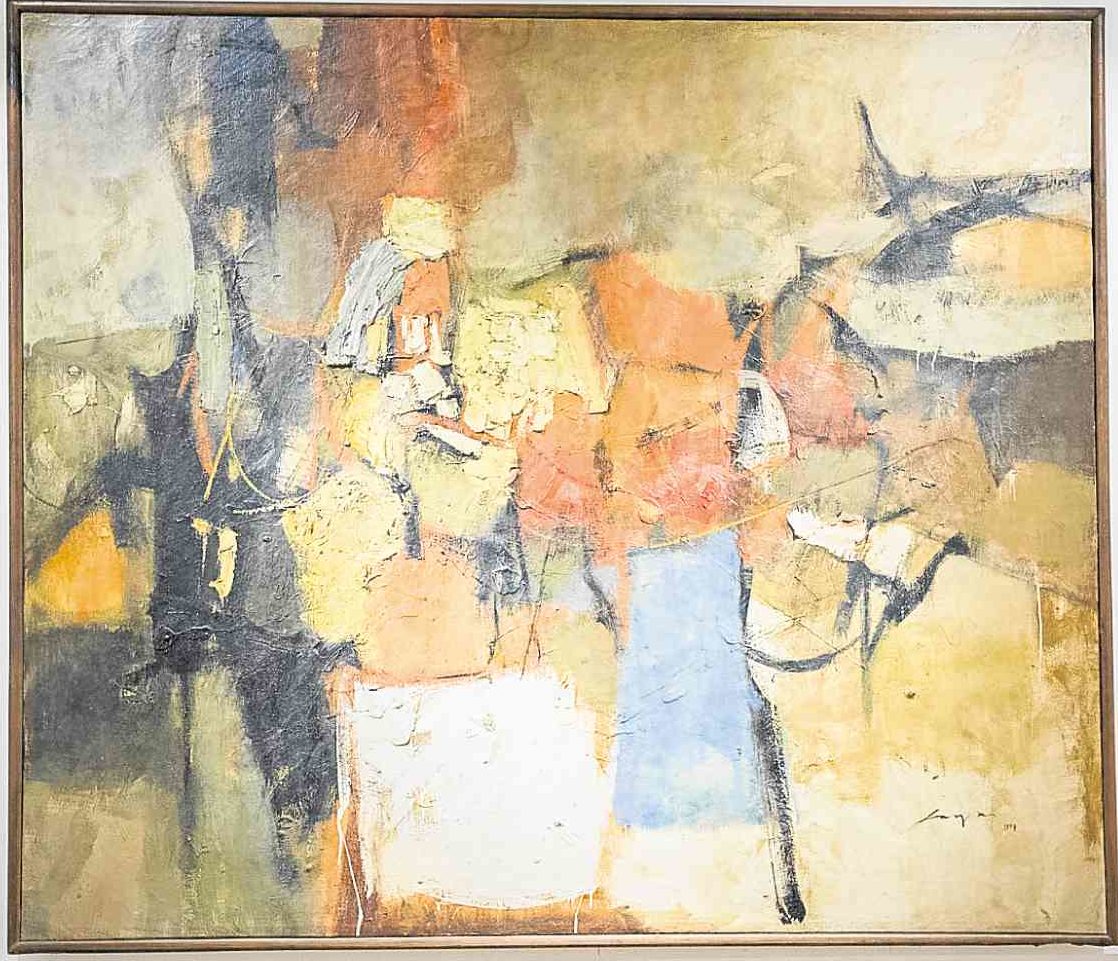
When news broke that “Space Transfiguration,” a 1959 abstract expressionist painting by the late National Artist Jose Joya, had sold last March for over P112 million—the highest price ever paid for a Philippine painting at auction—it drew two kinds of reactions.
The first was the self-congratulatory feeling that Philippine art had finally “arrived” on the global stage, as if a nine-figure price tag was the ultimate validation of its worth.
Artprice.com, the international art market monitor, said that “auctions secure the public validation of a masterpiece that would not be possible in a private sale. It thus provides public recognition of the masterpiece’s worth from the community of discerning collectors.”
Shortly after, Artprice reported that the Philippines was now the 17th-ranked art auction market in the world.

Special Joya
The second reaction reflected a more cynical mind-set: Could a modern painting really be worth that much, or is there more than meets the eye where auction prices are concerned?
No other Joya had ever cracked the top 10. The P112 million fetched by “Space Transfiguration” was nearly twice the amount paid for Number 2, P65.4 million for Ang Kiukok’s 1981 “Fishermen.”
A respected art appraiser and gallery owner, when asked, said that the P112 million price tag was for real, and that she knew both the buyer and the seller.
The painting belonged to the artist’s family, she said, and the original asking price was in the area of P60 million, so it was not inconceivable that, in the heat of bidding, it could reach the hammer price of P96 million. (The reported P112-million price tag includes the buyer’s premium, a percentage of the sale price paid the auction house by the buyer, on top of the commission it makes from the seller.)
“That Joya was special because it was the artist’s favorite and it was the last one the family sold,” she added. “They (the auction house) did a good job of marketing it. They were able to condition the buyers. That doesn’t mean that all Joyas of that size should be worth more than P100 million.”
Still, skepticism is widespread among certain artists, quite a number of whom studied under Joya, who was dean of the UP College of Fine Arts in the 1970s.
Only a few of them are inclined to take published prices at face value, preferring to believe the widespread conspiracy theory that auctions are rigged by a so-called “art mafia,” a shadowy cabal of collectors who manipulate supply and demand (and consequently, prices), just like rice cartels or Wall Street raiders.
In fact, neither viewpoint has been subjected to any deeper scrutiny. Are art auction prices for real? The simple answer, at this point, is “maybe.”
According to Artprice, the global art market generated $8.45 billion in the first six months of 2018.
“There’s no mistake that because it is an emergent economy and affluence is growing in the Philippines, there is growth in the prices and interest in art,” says Richie Lerma, director of the Makati-based auction house Salcedo Auctions.
“What needs to be said, though, is that because it is a growing industry, there is need for regulation. Because when it comes to economics, runaway prices, specially perceived prices, could lead to a bubble.”

Bubbles
Such bubbles occur periodically in the art world when hype overtakes prudence and collectors overpay for an artwork.
Market forces eventually effect a correction, leaving the overenthusiastic collectors unable to sell the works at prices they originally paid for them.
“When does a bubble start?” he continues. “It starts when a lot of these ideas regarding value become conjecture, and people are persuaded to part with their money, when in fact there is no regulation in place to verify the veracity of whatever prices are announced.
“It’s as simple as this: You are told that a work of art sold for P100 million. How do you know that it actually sold for P100 million? How do you know that money actually changed hands at that level? How do you verify the authenticity of the sale? It all boils down to what was announced by the entity conducting the auction.”
And when these winning bids are reported in media, they are legitimized. The resulting media hype favors the auction’s major players, from the auction house and the seller to the buyer, the artist, although it could make the artist’s other works unaffordable to other collectors.
Even the prices published by Artprice.com, says Lerma, could stand greater scrutiny.
“Artprice does not verify announced results,” he says. “It’s only recently that the Philippines entered the auction scene. Auctions started in countries such as the US, Australia and Europe where there’s relative transparency. In other words, where there’s a way for authorities to check whether or not money actually moved.
“Here in the Philippines, I’m not familiar with what checks and balances there are to see how money moved,” he adds.
“In fact, we have regulations to prevent that from being done. It’s all hearsay. There’s no concrete evidence that money actually moved.”
A former director of the Ateneo Art Gallery and founder of the Ateneo Art Awards, Lerma restarted the auction scene in the Philippines when he opened Salcedo Auctions with his wife, Karen, in 2010.
Salcedo has since been joined by Leon Gallery, Finale Auctions in what has become a burgeoning fine art and collectible auction industry in the country that is still in the early stages of development.

Watches
It’s not only fine art that’s moving through the auction houses at astonishing rates. Watches, jewelry, coins, stamps and other collectibles are also hot items.
In the last auction at Salcedo Auction’s Gavel and Block subsidiary, a collector paid nearly P80,000 for a vintage, die-cast Voltes V figurine.
“All I’m saying is that people need to be more circumspect and discerning when it comes to announced auction prices, because there’s no way to check,” says Lerma.
“It’s easier to verify a property transaction because there’s paperwork involved,” he adds.
“There is no paperwork involved in an art transaction, no title transfer, only certificates of sale and certificates of authenticity. For some, that’s the beauty of collecting art. But at the same time, within an unregulated environment, the mode in which art changes ownership can make it susceptible to abuse.”
Hypothetically, inflating announced auction prices benefits collectors because works of the same artist appreciate in value. It benefits the auction house because it attracts more sellers who now think they can get better prices for their artworks.
Buyers get to value their purchases higher than they actually paid for it. And of course, sellers still get the price they want for the artwork.
This scenario, of course, assumes collusion between the parties involved.
‘Shill’
There is also the possibility of so-called “shill” bidding, where prices are inflated by a fake bidder—the “shill”—who bids against the prospective buyer, raising the price of an artwork.
One serious collector, who prefers to remain anonymous, said that an auction house sometimes resorts to this to ensure that an item meets the reserve price, the lowest price which a seller will accept, which is hidden from the bidders.
Any artwork that remains unsold after an auction usually suffers a drastic price slash, bad for all parties concerned.
“In other countries, there are regulations in place to prevent this,” says Lerma. “In fact, CEOs of auction houses have gone to jail because they were caught colluding. Here, it’s the wild, wild west.”
One possible remedy is self-regulation within the auction industry.
“There should be a professional body among colleagues where members have to abide by certain standards,” says Lerma.
This is specially true when the auction house is also a gallery, he adds.
“People are confused about the difference between an auction house, and a gallery that holds auctions,” he says.
“An auction house has no financial interest in the pieces that it offers, whereas a gallery has inventory that it needs to move.”
In the latter case, he says, the conduct of an auction could potentially be influenced.
“On the national level, because we’re talking about people’s hard-earned money and economic future, there should be some legislation in place. There is no auction law in the Philippines, there is no law saying shill bidding is illegal,” he says.
“It’s all about fair trade,” he adds. “If you are made to believe, through shill bidding, that a piece is worth P100 million, and you suddenly need money, how do you cash out?”
As for the so-called “art mafia,” even they have their limits, he suggests.
“You have collectors propping up prices of certain artists hoping that other collectors will get interested and jump in. But discerning art collectors know about that art mafia, and they can see that it’s the same people bidding for these pieces. After a while the people bidding for this artist get tired and think maybe they’re backing the wrong (cock).”
Artists are not immune. Their reputations, and consequently the prices of their work, could suffer.
“There have been major corrections for certain artists, who shall remain nameless, hyped to be the next auction stars but whose prices have fizzled out completely,” observes Lerma.
Nevertheless, despite all the skullduggery seemingly taking place behind the scenes, there is genuine reason to be excited about the prospects of Philippine art.
“These are exciting times,” says Lerma. “There’s so much interest in art and auctions, and given that it’s grown to this level, it needs rules and regulations in place so that people can continue to be confident in the market, confident in the process. It’s all part and parcel of the growing maturity of the Philippine art market and art buyer.”












































